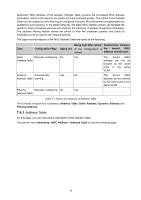TP-Link TL-SL5428E User Guide - Page 52
LACP Config
 |
UPC - 845973020873
View all TP-Link TL-SL5428E manuals
Add to My Manuals
Save this manual to your list of manuals |
Page 52 highlights
Figure 7-6 Manually Config The following entries are displayed on this screen: ¾ LAG Config Group Number: Select a Group Number for the LAG. Description: Give a description to the LAG for identification. ¾ LAG Table Member Port: Select the port as the LAG member. Clearing all the ports of the LAG will delete this LAG. Tips: 1. The LAG can be deleted by clearing its all member ports. 2. A port can only be added to a LAG. If a port is the member of a LAG or is dynamically aggregated as the LACP member, the port number will be displayed in gray and can not be selected. 7.2.3 LACP Config LACP (Link Aggregation Control Protocol) is defined in IEEE802.3ad and enables the dynamic link aggregation and disaggregation by exchanging LACP packets with its partner. The switch can dynamically group similarly configured ports into a single logical link, which will highly extend the bandwidth and flexibly balance the load. With the LACP feature enabled, the port will notify its partner of the aggregation ID (consist of System Priority, system MAC address and the Admin Key). A dynamic aggregation group will only be formed between ports having the same aggregation ID. Up to fourteen aggregation groups can be formed by the switch. If the amount of the configured aggregation groups exceeds the maximum number, the group with smaller System Priority takes the priority to be aggregated. Similarly, up to eight ports can be selected in an aggregation group. Therefore, the port also has the priority to be selected as the dynamic aggregation group member. The port with smaller Port 44















